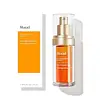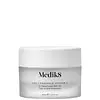What's inside
What's inside
 Key Ingredients
Key Ingredients

 Benefits
Benefits

 Concerns
Concerns

 Ingredients Side-by-side
Ingredients Side-by-side

Water
Skin ConditioningGlycerin
HumectantCaprylic/Capric Triglyceride
MaskingGlycolic Acid
BufferingDimethicone
EmollientHdi/Trimethylol Hexyllactone Crosspolymer
Diisopropyl Sebacate
EmollientC13-16 Isoparaffin
SolventSodium Hydroxide
BufferingPolyacrylate Crosspolymer-6
Emulsion StabilisingLactic Acid
BufferingDimethyl Isosorbide
SolventAscorbic Acid
AntioxidantUrea
BufferingYeast Amino Acids
HumectantTrehalose
HumectantInositol
HumectantTaurine
BufferingBetaine
HumectantGlutathione
Tetrahexyldecyl Ascorbate
AntioxidantGold
Cosmetic ColorantMarrubium Vulgare Extract
Skin ConditioningVerbascum Thapsus Extract
Skin ConditioningZanthoxylum Bungeanum Fruit Extract
Skin ConditioningXymenynic Acid
EmollientTerminalia Ferdinandiana Fruit Extract
AntioxidantChlorella Vulgaris Extract
Skin ConditioningHexylresorcinol
AntimicrobialTocopheryl Acetate
AntioxidantTocopherol
AntioxidantCetearyl Isononanoate
EmollientOleyl Alcohol
EmollientButylene Glycol
HumectantPolysilicone-11
Triheptanoin
Skin ConditioningPolyisobutene
Ethylhexylglycerin
Skin ConditioningSilica
AbrasiveHydroxyethyl Acrylate/Sodium Acryloyldimethyl Taurate Copolymer
Emulsion StabilisingSodium Surfactin
CleansingHexylene Glycol
EmulsifyingPEG-7 Trimethylolpropane Coconut Ether
EmulsifyingSorbitol
HumectantXanthan Gum
EmulsifyingDecyl Glucoside
CleansingPropanediol
SolventSorbitan Isostearate
Emulsifying1,2-Hexanediol
Skin ConditioningLeuconostoc/Radish Root Ferment Filtrate
AntimicrobialTin Oxide
AbrasiveCitric Acid
BufferingCaprylyl Glycol
EmollientPhenoxyethanol
PreservativeSodium Benzoate
MaskingPotassium Sorbate
PreservativeMica
Cosmetic ColorantCI 77891
Cosmetic ColorantTea-Sulfate
BufferingSoy Protein Phthalate
EmollientGlutaral
PreservativeParaffinum Liquidum
EmollientFormaldehyde
Benzophenone-3
UV AbsorberPetrolatum
EmollientWater, Glycerin, Caprylic/Capric Triglyceride, Glycolic Acid, Dimethicone, Hdi/Trimethylol Hexyllactone Crosspolymer, Diisopropyl Sebacate, C13-16 Isoparaffin, Sodium Hydroxide, Polyacrylate Crosspolymer-6, Lactic Acid, Dimethyl Isosorbide, Ascorbic Acid, Urea, Yeast Amino Acids, Trehalose, Inositol, Taurine, Betaine, Glutathione, Tetrahexyldecyl Ascorbate, Gold, Marrubium Vulgare Extract, Verbascum Thapsus Extract, Zanthoxylum Bungeanum Fruit Extract, Xymenynic Acid, Terminalia Ferdinandiana Fruit Extract, Chlorella Vulgaris Extract, Hexylresorcinol, Tocopheryl Acetate, Tocopherol, Cetearyl Isononanoate, Oleyl Alcohol, Butylene Glycol, Polysilicone-11, Triheptanoin, Polyisobutene, Ethylhexylglycerin, Silica, Hydroxyethyl Acrylate/Sodium Acryloyldimethyl Taurate Copolymer, Sodium Surfactin, Hexylene Glycol, PEG-7 Trimethylolpropane Coconut Ether, Sorbitol, Xanthan Gum, Decyl Glucoside, Propanediol, Sorbitan Isostearate, 1,2-Hexanediol, Leuconostoc/Radish Root Ferment Filtrate, Tin Oxide, Citric Acid, Caprylyl Glycol, Phenoxyethanol, Sodium Benzoate, Potassium Sorbate, Mica, CI 77891, Tea-Sulfate, Soy Protein Phthalate, Glutaral, Paraffinum Liquidum, Formaldehyde, Benzophenone-3, Petrolatum
Water
Skin ConditioningTetrahexyldecyl Ascorbate
AntioxidantDiethylamino Hydroxybenzoyl Hexyl Benzoate
UV FilterDibutyl Adipate
EmollientDimethicone
EmollientEthylhexyl Triazone
UV AbsorberBis-Ethylhexyloxyphenol Methoxyphenyl Triazine
Skin ConditioningC12-15 Alkyl Benzoate
AntimicrobialDicaprylyl Carbonate
EmollientCetearyl Alcohol
EmollientGlycerin
HumectantCoco-Glucoside
CleansingPhenoxyethanol
PreservativeAcrylates/C10-30 Alkyl Acrylate Crosspolymer
Emulsion StabilisingCetearyl Glucoside
EmulsifyingTocopheryl Acetate
AntioxidantHydroxyacetophenone
AntioxidantDisodium EDTA
Benzoic Acid
MaskingXanthan Gum
EmulsifyingCitrus Grandis Peel Oil
MaskingSodium Hydroxide
BufferingDehydroacetic Acid
PreservativeSodium Hyaluronate
HumectantCitrus Limon Peel Oil
MaskingCitrus Aurantium Bergamia Fruit Oil
MaskingPelargonium Graveolens Flower Oil
MaskingEthylhexylglycerin
Skin ConditioningLimonene
PerfumingCitronellol
PerfumingLinalool
PerfumingGeraniol
PerfumingCitral
PerfumingWater, Tetrahexyldecyl Ascorbate, Diethylamino Hydroxybenzoyl Hexyl Benzoate, Dibutyl Adipate, Dimethicone, Ethylhexyl Triazone, Bis-Ethylhexyloxyphenol Methoxyphenyl Triazine, C12-15 Alkyl Benzoate, Dicaprylyl Carbonate, Cetearyl Alcohol, Glycerin, Coco-Glucoside, Phenoxyethanol, Acrylates/C10-30 Alkyl Acrylate Crosspolymer, Cetearyl Glucoside, Tocopheryl Acetate, Hydroxyacetophenone, Disodium EDTA, Benzoic Acid, Xanthan Gum, Citrus Grandis Peel Oil, Sodium Hydroxide, Dehydroacetic Acid, Sodium Hyaluronate, Citrus Limon Peel Oil, Citrus Aurantium Bergamia Fruit Oil, Pelargonium Graveolens Flower Oil, Ethylhexylglycerin, Limonene, Citronellol, Linalool, Geraniol, Citral
Ingredients Explained
These ingredients are found in both products.
Ingredients higher up in an ingredient list are typically present in a larger amount.
Dimethicone is a type of synthetic silicone created from natural materials such as quartz.
What it does:
Dimethicone comes in different viscosities:
Depending on the viscosity, dimethicone has different properties.
Ingredients lists don't always show which type is used, so we recommend reaching out to the brand if you have questions about the viscosity.
This ingredient is unlikely to cause irritation because it does not get absorbed into skin. However, people with silicone allergies should be careful about using this ingredient.
Note: Dimethicone may contribute to pilling. This is because it is not oil or water soluble, so pilling may occur when layered with products. When mixed with heavy oils in a formula, the outcome is also quite greasy.
Learn more about DimethiconeEthylhexylglycerin (we can't pronounce this either) is commonly used as a preservative and skin softener. It is derived from glyceryl.
You might see Ethylhexylglycerin often paired with other preservatives such as phenoxyethanol. Ethylhexylglycerin has been found to increase the effectiveness of these other preservatives.
Glycerin is already naturally found in your skin. It helps moisturize and protect your skin.
A study from 2016 found glycerin to be more effective as a humectant than AHAs and hyaluronic acid.
As a humectant, it helps the skin stay hydrated by pulling moisture to your skin. The low molecular weight of glycerin allows it to pull moisture into the deeper layers of your skin.
Hydrated skin improves your skin barrier; Your skin barrier helps protect against irritants and bacteria.
Glycerin has also been found to have antimicrobial and antiviral properties. Due to these properties, glycerin is often used in wound and burn treatments.
In cosmetics, glycerin is usually derived from plants such as soybean or palm. However, it can also be sourced from animals, such as tallow or animal fat.
This ingredient is organic, colorless, odorless, and non-toxic.
Glycerin is the name for this ingredient in American English. British English uses Glycerol/Glycerine.
Learn more about GlycerinPhenoxyethanol is a preservative that has germicide, antimicrobial, and aromatic properties. Studies show that phenoxyethanol can prevent microbial growth. By itself, it has a scent that is similar to that of a rose.
It's often used in formulations along with Caprylyl Glycol to preserve the shelf life of products.
Sodium Hydroxide is also known as lye or caustic soda. It is used to adjust the pH of products; many ingredients require a specific pH to be effective.
In small amounts, sodium hydroxide is considered safe to use. However, large amounts may cause chemical burns due to its high alkaline.
Your skin has a natural pH and acid mantle. This acid mantle helps prevent harmful bacteria from breaking through. The acid mantle also helps keep your skin hydrated.
"Alkaline" refers to a high pH level. A low pH level would be considered acidic.
Learn more about Sodium HydroxideTetrahexyldecyl Ascorbate (THD) is a stable and oil-soluble form of Vitamin C.
THD is special in that it has the ability to travel deeper into skin than traditional ascorbic acid while maintaining the same skin benefits (double win!).
Because it’s oil-soluble, THD dives deep into your skin’s fatty layers (think ceramides and cholesterol) to fight off the kind of free radicals that mess with your skin barrier. This makes it a great pair with water-based vitamin C (ascorbic acid) that mainly works on the surface.
Even at just 0.1%, THD is already showing great antioxidant activity. When used up to 2%, it helps keep your skin happy and calm, especially when it’s stressed from pollution or sun.
Want to fade dark spots or tackle hyperpigmentation? You’ll want 5% or more. Pairing it with brightening buddies like niacinamide or licorice root gives even better results. One study even used 30% THD with other brighteners and saw real results on stubborn discoloration, even in melasma-prone skin.
A note on THD: It’s has a slightly silky, oily texture and usually shows up colorless or pale yellow (though the exact shade can vary by supplier).
While you can sneak it into water-based formulas, it really shines when paired with silicones or oils, which help your skin soak it up better.
THD is pretty stable, but it’s still vulnerable to degradation like ascorbic acid. Too much light or heat (above 113°F / 45°C) can break it down over time. Go for dark and opaque packaging that keeps it safe and shady!
Read more about other types of Vitamin C:
Learn more about Tetrahexyldecyl AscorbateTocopheryl Acetate is AKA Vitamin E. It is an antioxidant and protects your skin from free radicals. Free radicals damage the skin by breaking down collagen.
One study found using Tocopheryl Acetate with Vitamin C decreased the number of sunburned cells.
Tocopheryl Acetate is commonly found in both skincare and dietary supplements.
Learn more about Tocopheryl AcetateWater. It's the most common cosmetic ingredient of all. You'll usually see it at the top of ingredient lists, meaning that it makes up the largest part of the product.
So why is it so popular? Water most often acts as a solvent - this means that it helps dissolve other ingredients into the formulation.
You'll also recognize water as that liquid we all need to stay alive. If you see this, drink a glass of water. Stay hydrated!
Learn more about WaterXanthan gum is used as a stabilizer and thickener within cosmetic products. It helps give products a sticky, thick feeling - preventing them from being too runny.
On the technical side of things, xanthan gum is a polysaccharide - a combination consisting of multiple sugar molecules bonded together.
Xanthan gum is a pretty common and great ingredient. It is a natural, non-toxic, non-irritating ingredient that is also commonly used in food products.
Learn more about Xanthan Gum